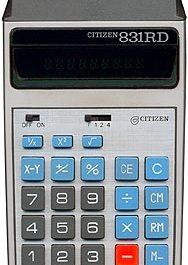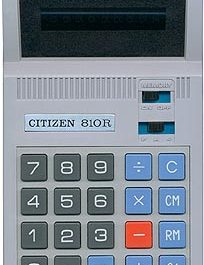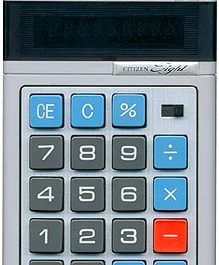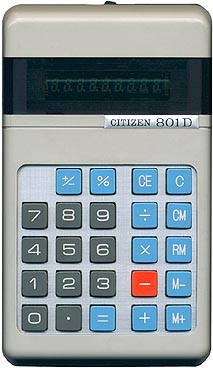
The Citizen 801D calculator, released around 1976, is a sleek device, with its light grey front and dark grey back. It measures approximately 82mm x 136mm x 25mm and weighs a mere 132g without batteries. The calculator’s design showcases a rounded two-piece plastic case, featuring a flush, wrap-around green plastic display filter that provides a clean, crisp image.
At the heart of the Citizen 801D lies a Matsushita M58618-83P 582E CPU, a 28-pin DIL chip that drives its computational capabilities. The calculator’s interface is dominated by a large brushed aluminum panel, slightly inset, reminiscent of many GICO keyboards of the era. The soft, squishy keys, subtly colored, offer a tactile experience that belies their responsiveness.

The Citizen 801D boasts an 8-digit green vacuum fluorescent display (VFD), with an additional ninth digit for minus, error, and memory indicators. This bright, clear display sets it apart from many contemporaries and draws comparisons to the Decimo Vatman series.

Powered by four AA batteries providing 6.0V DC, the calculator also accepts an adapter/charger (CTZ-800R 6V DC 0.25W, centre negative) through a socket on the top right side. The on/off switch is conveniently located in the middle of the top side.

Functionally, the Citizen 801D offers four basic arithmetic operations along with percentages, change sign, and a four-function memory. While these features were standard for its time, the calculator’s implementation of them showcases the advancing sophistication of handheld computing devices in the mid-1970s.
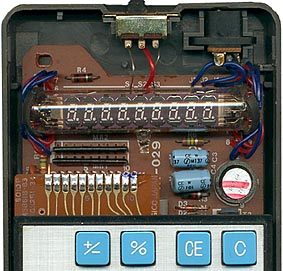
The internal construction of the Citizen 801D is noteworthy. The keyboard assembly (801DP 458618-83 GK251-34, GICO Japan) sits loosely atop the main board, connected by 11 wires. This design, while potentially challenging for repairs, speaks to the modular thinking that was beginning to permeate electronics manufacturing.
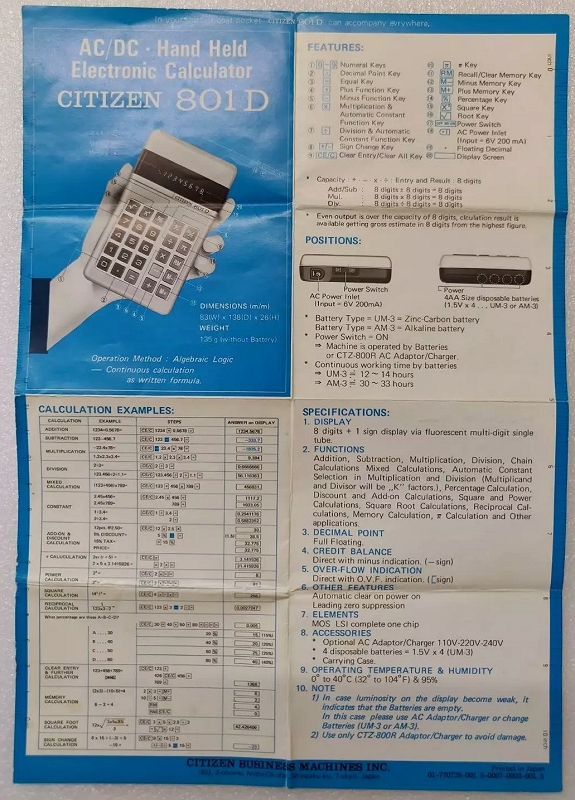
Logic:
- The (CE) key clears the last entry of a number, while the (C) key clears the entire calculator.
- Input overflow is suppressed; inputting a ninth digit is ignored.
- Automatic constant function is available on all four arithmetic operations.
- Negative numbers are displayed with a “-” in the far left (ninth) digit, allowing for full eight-digit negative numbers.
- The change sign function can be used mid-number entry.
- Overflow results are displayed with a “C” (or “E” if negative) in the far left digit and are not recoverable.
- Division by zero results in a tall “C” in the far left digit, also not recoverable.
- Memory storage is indicated by the decimal point of the far left digit.
- The calculator exhibits the “negative zero” bug, a quirk found in some early electronic calculators.

The Citizen 801D represents a fascinating snapshot of mid-1970s calculator technology. Its blend of functional design, advanced display technology, and comprehensive (if sometimes quirky) arithmetic capabilities make it a noteworthy piece of computing history. While it may lack some of the more advanced functions of later models, its clear display, tactile keyboard, and logical operation would have made it a valuable tool for both business and personal use in its day.
